
TIPS and TECHNIQUES
Click on the hyperlink below to jump to the section:
Dial Bevel Protractors for Angle Measurement
Triangle Inserts in Segment Rings
Dial Bevel Protractors for Angle Measurement
Over the years, I have purchased many different types of protractors for measuring angles and have never been very satisfied with any of them. Recently, I discovered dial bevel protractors. They have been around for years but I didn't know it. I purchased four different types of dial bevel protractors and found that these two types, pictured below, are the easiest to use. They are both fairly inexpensive and VERY accurate.
Both types of dial bevel protractors pictured below are highly recommended. The other types (not pictured) are not recommended because they were either too difficult for most people to use (vernier scales) or were not properly calibrated (angles were off). I purchased both of these dial bevel protractors on eBay. Whatever you buy, you need to test the bevel protractor calibration against a precision square to make sure the bevel protractor reads 90 degrees with the square. Search eBay for "bevel protractor" to find them.
Both dial bevel protractors show angle degrees directly on the dial. For angles less than one degree, both dial bevel protractors show angles in minutes of arc, so you will need a calculator to help you set the dial bevel protractor to the angle you want. All you have to do to convert tenths of a degree to minutes is to multiply the tenths of a degree by 60 to get minutes. For example, 0.8 degree x 60 = 48 minutes. My Table Saw Miter Angles program can be easily configured to show calculated angles in degrees and minutes for use with dial bevel protractors.
When measuring an angle with either dial bevel protractor the angle will be read as degrees and minutes. All you have to do to convert minutes to degrees is to divide the minutes by 60 to get degrees. For example, 48 minutes / 60 = 0.8 degrees.
A good source for stone chips is Arizona Silhouette.
1. The wood surrounding the groove can
be
protected from glue staining with sanding sealer or something similar.
2. The groove should be at minimum 1/16" deep. If the groove is
overly deep you can fill it partway with sawdust and glue.
3. Fill the groove with dry stone (no glue). Overfill the
groove a
little.
4. Drizzle water-thin superglue over the stone.
5. I usually use glue accelerator, but to avoid turning the glue
white, I
use a very fine mist of aerosol accelerator so the glue will harden
just enough
so the stone won't fall out.
6. Sand the stone mostly flat.
7. Fill any voids around the stone with medium-thickness
superglue.
8. Final sand and fill voids again with medium-thickness
superglue as necessary then
resand.
Tip: Don't use stone dust. It can end up looking like paint rather than stone chip inlay. Medium coarse stone is better than fine stone because it looks more natural. You might find jade is too difficult to sand. I wouldn't use any stone harder than lapis. Turquoise and malachite are relatively easy to sand.
Triangle Inserts in Segment Rings
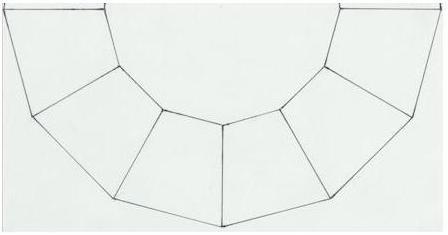 |
STEP 1. Cut the segments for your flat ring. Make sure they make a reasonably good circle but don't glue anything together yet. This example shows a 12-segment ring. The sled fence was set at 15 degrees to cut the segments. |
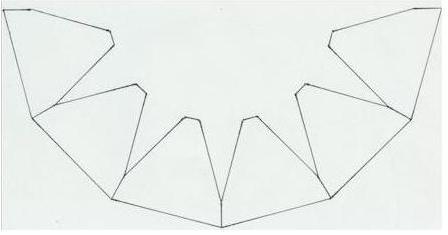 |
STEP 2. To insert triangles into the segment ring each segment must be cut twice. Because part of the triangle will be covered up by the lip ring (or the next ring) I chose to make the height of each triangle about 75% of the board width I used to cut the segments so there would be plenty visible triangle in the finished bowl. Note that I left a small space between the triangle cutouts so the base of the inserted triangles would not overlap. The space dimension should be larger than zero. I decided that this ring could best use triangles with angles 75-75-30 degrees. Triangles with any angles can be used. You just need to know the angle. I suggest that you draw the triangle on a pair of segments then measure the triangle's vertex angle (30 degrees in this example). |
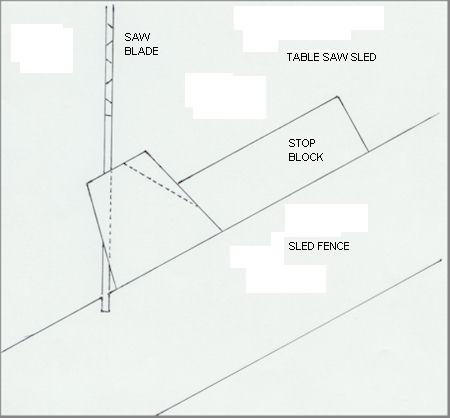 |
STEP2 CONTINUED. Cut the corners off the segments. This is the table saw setup for cutting corners off the segments. For safety, please use the appropriate clamps and holddowns. The sled fence angle in this example was adjusted to 30 degrees, which is the segment miter angle (15 degrees) plus half the triangle vertex angle (30/2= 15 degrees). Cut one side of the segment then flip the segment and cut the other side. |
 |
STEP 3. First, rip a board to slightly larger width than the height of your triangles. The triangles will be cut sequentially from the board, in other words: cut, flip, cut, flip, etc. |
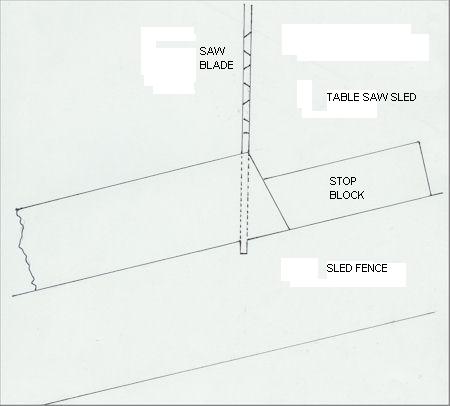 |
STEP 3 CONTINUED. Cut the triangles. The sled fence in this example was adjusted to 15 degrees, which is half the triangle vertex angle (30/2=15 degrees). For safety, please use the appropriate clamps and holddowns. Cut the end of your triangle board. Then set the stop block to the appropriate distance so that the triangle will have a sharp point. Cut a triangle then make sure the angle is correct by dry-fitting it into a pair of segments. If OK then continue cutting the triangles. Veneer can be glued to the triangle sides to further define the triangles from the segments, at least I usually do.
|
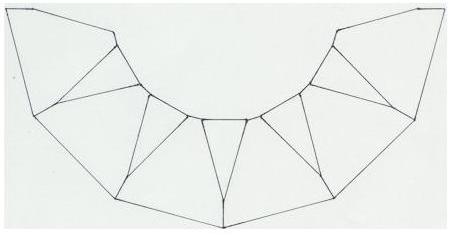 |
STEP 4. Glue the triangles to the segments. I usually start by gluing a pair of segments and a triangle together, sometimes with a rubber band around the assembly. After all the pairs of segments are glued with their triangles I will continue gluing pairs of segments to pairs of segments with another triangle. If these instructions were helpful to you please let me know. Thanks and good luck !! |
If you have any requests, please email me.